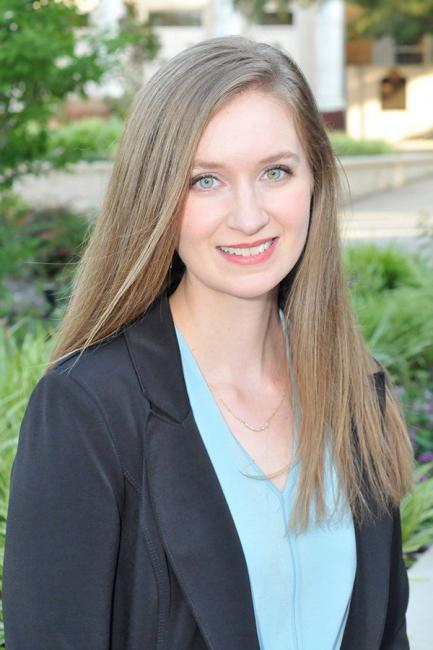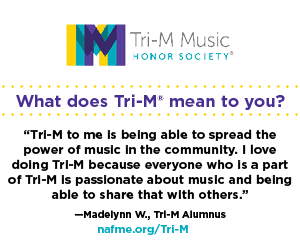/ News Posts / Developing a Sense of Community in Online Learning Environments
Developing a Sense of Community in
Online Learning Environments
A Research-to-Resource Article from
UPDATE: Applications of Research in Music Education
By NAfME Member Kari Adams
This article first appeared in the February 2021 issue of
UPDATE: Applications of Research in Music Education.
Abstract
Many music educators are concerned about building healthy classroom communities as they prepare to transition to online or blended learning environments. Research involving distance education has indicated that several techniques in the design and delivery of online instruction can increase students’ sense of community, commitment to the course, and overall learning experience. The purpose of this research-to-resource article is to provide music educators with research-based strategies for establishing and connecting students to a sense of community in courses delivered partially or entirely online.
Educational researchers and pedagogues agree that a sense of community is an indicator of a successful classroom (Baker & Moyer, 2019; Chatterjee & Correia, 2020; Liu et al., 2007). Music educators recognize the importance of community in their classrooms; developing community is often considered a top priority at the start of the semester (Parker, 2016). Many music educators, facing the move to online or blended learning environments, have recently expressed concerns about building the same community feeling in online instruction. These concerns have long plagued those teaching remotely, yet Edwards et al. (2011) noted that “the sometimes purported beliefs that it is difficult to create a shared community online . . . might not be the case” (p. 114). The use of specific strategies can help develop community in an online learning environment; often these strategies also enrich the learning experience, increase student autonomy, and improve pedagogical practice. The purpose of this research-to-resource article is to provide music educators with research-based strategies for establishing and connecting students to a sense of community in courses delivered partially or entirely online.
Connection
It is impossible to create a sense of community without fostering connections. Engagement and commitment in the classroom depend on connections among students, between students and teachers, and between students and content (Corso et al., 2013). Although it may be more challenging to foster connections online, many technological tools can increase feelings of connectedness.
The use of video and audio for both teachers and students may add a level of connection missing from written text alone. Researchers have noted the effectiveness of video and audio instruction, which allow students to see and hear the instructor and each other (Bickle & Rucker, 2018; Lewis, 2018). In asynchronous (i.e., all content available via a learning management system with no synchronous meetings) courses, teachers may consider delivering content via video or audio formats. Students can also post introductory videos, presentations, or discussion responses to see and hear one another. Providing audio feedback is another way educators can connect with students. Tools such as Screencastify allow the teacher to record audio feedback over screen capture of student work. In addition to increasing the level of connection, this method of providing feedback is often far less time consuming for the teacher.
In synchronous (i.e., taking place at the same time via a videoconferencing platform) classes, some elements of connection carry over from face-to-face instruction. Just as in a face-to-face classroom, teachers should greet every student by name and encourage student interaction at the start of class. Because it is more difficult to talk one-on-one with students in online settings, educators can contact students individually via e-mail at the beginning of the semester. This is an excellent way to thank students for being in the class and ask about their previous positive and negative experiences with online instruction. Additionally, teachers could use e-mail to solicit student feedback concerning their experience in the course, their sense of community, and suggestions for improvement.
In an asynchronous course, educators might consider providing optional synchronous class meetings to allow students the opportunity to interact. If attendance is optional, the teacher can post a recording of the meeting for those who cannot attend. Also, teachers could host a videoconference office hour for students in all of the course sections they are teaching. The teacher would commit to being on the videoconference platform at a designated time and students could log on to ask questions or converse.
Feedback
Soliciting and implementing student feedback is a powerful way to build community in the classroom, and researchers have indicated that it is a useful practice in online learning as well (Erwin, 2004; Farmer et al., 2016). In Lewis’s (2018) autoethnography of her transition to online instruction, she noted that regularly soliciting feedback from students was integral to the development of community. She sought feedback concerning classroom environment, her own teaching practices, and the use of technology. Lewis noted that students often were able to provide her with technology-related ideas and tools that she would not have found on her own. The use of feedback can increase students’ connection and commitment to one another, engagement in the course, and overall learning experience. When implemented, feedback may also have the added benefit of improving the teacher’s pedagogical practice.
One structured format for encouraging student feedback is the cogenerative dialogue group. Cogenerative dialogues are goal-oriented conversations among students and teachers about shared experiences designed to increase a sense of community and improve pedagogical practice (Tobin & Roth, 2005). In a cogenerative dialogue group, or cogen, four students meet with the teacher outside of class to discuss classroom environment and cocreate an action plan for improvement. Scholars have primarily examined cogenerative dialogues within the context of urban education (Emdin, 2017), but they are applicable to any classroom, especially those in which the environment is new or unfamiliar.
Emdin (2010) used cogens in two urban high schools to build classroom culture and improve teaching practices, two concerns that are present given educators’ current shift to online learning structures. Cogens can provide a structured format for teachers to solicit feedback and allow students to play an active role in problem solving. Cogenerative dialogues focus on classroom environment and teaching practice. Teachers might open a cogenerative dialogue by asking students to rate or describe their sense of community in the course and identify areas of weakness. Conversations could also center on teaching practice. For example, teachers might ask students to identify teaching strategies that are working and those that are not. After identifying strengths and weaknesses, the students and teacher can work together to create and implement an action plan for improvement.
Handled improperly, cogens can lead to cliques and hierarchies in the classroom (Emdin & Lehner, 2006; Stith et al., 2006). Therefore, Emdin (2017) recommended rotating students in and out of cogens in a systematic way to avoid cliques while maintaining momentum. After three cogen meetings, he recommended introducing a classroom job which any student can opt to take if they volunteer to leave the group and invite their own replacement. This system will allow membership to rotate on a volunteer basis, increase the number of students involved in the dialogues, and maintain established norms by exchanging only one member at a time. Because cogens allow students to create pedagogical plans, they are especially applicable to courses involving preservice teachers.
Coteaching
Another practice outlined by Emdin (2017) that could benefit the online classroom is coteaching. Emdin distinguished between traditional coteaching, in which multiple teachers instruct the class together, and the style of coteaching in which students take on the role of instructor. According to Emdin (2017), coteaching in this way will allow “shared power between students and teachers, and peer-to-peer communication . . . during the class” (p. 99). Coteaching practices encourage students to develop agency and allow teachers to learn with and from students as content knowledge and pedagogy are cocreated (Edwards et al., 2011).
Karvelis (2017) found success with Emdin’s (2017) style of coteaching in his general music classes. Karvelis’s students participated in coteaching by connecting difficult rhythms to popular songs they knew and sharing these examples with classmates and teaching a unit on popular music based on materials he provided. Coteaching provided an avenue for students to connect to a sense of community in the class while also supplying the teacher with pedagogical ideas applicable to future instruction. Emdin (2017) argued that students, although not trained pedagogically, are able to enact aspects of their ideal style of teaching. He encouraged educators to examine student coteaching for strategies they could use in their own teaching practice.
Researchers have found positive attitudes toward online coteaching as well. In a qualitative study exploring faculty and student perspectives of the ideal online learning environment (Shearer et al., 2020), both faculty and student participants described a classroom in which students take an active role in content creation and design. Students expressed positive opinions concerning the sense of community in Lewis’s (2018) asynchronous online course when she involved them in coteaching. Students signed up for a week during the semester when they, along with a peer, would serve as facilitators for the weekly discussion board. In their chosen week, the students designed a 15-minute interactive activity and moderated the weekly discussion board.
In order to engage in coteaching, the instructor must provide students with materials normally used to deliver content (e.g., objectives, textbook chapters, online resources) and allow students to create a lesson plan. At the beginning of the process, educators may choose to view the lesson plan prior to the teaching phase but should refrain from making changes. The purpose of coteaching is to increase autonomy, deepen connection, and allow the educator to learn from students’ teaching styles. While students are teaching, the teacher should participate only in the student role—not interrupting or correcting, but taking notes on content delivery (Emdin, 2017). Coteaching, like cogenerative dialogues, increase student commitment and connection to the class while also providing important pedagogical information for the instructor.
Collaborative Work
Researchers have discovered that the use of collaborative work in online learning environments encouraged a sense of community among students (Chatterjee & Correia, 2020; Knupfer et al., 1997; Lewis, 2018; Tseng et al., 2019). Knupfer et al. (1997) recommended establishing study groups early in the semester to help build a sense of community. Similarly, Lewis (2018) used peer groups to develop rapport among students. Groups in her class collaborated and created video presentations together, which also increased connection through the use of audiovisual tools.
In synchronous class meetings, educators can use breakout rooms to allow students to collaborate in pairs or small groups. For example, students could collaborate on a score study exercise in small groups or work on conducting gesture in pairs. Outside of class, students could collaborate on lesson plans, arrange and perform a small ensemble piece, or create a presentation on a composer or music style. When assigning collaborative group projects, instructors of synchronous online courses might consider allowing students to meet during normally scheduled class time. Given the complex feelings students sometimes hold toward group work, this gesture can communicate that collaboration is important and that student time is valued. It also may increase the likelihood that students will use the time to meet via videoconferencing instead of dividing work among individuals with little or no collaboration.
Collaborative work can provide opportunities for students to get to know one another and increase the connection students feel to the class as a whole. The more students see and hear one another and the teacher, the more they are able to develop the connections that build a sense of community. In fact, engagement in collaborative learning has been positively correlated to high levels of trust among classmates, an integral aspect of psychological safety (Tseng et al., 2019).
Psychological Safety
Organizational culture researchers regard psychological safety as one of the most important components of a strong culture or community (Coyle, 2019; Edmondson & Lei, 2014; Kahn, 1990). People feel psychologically safe when they trust other members of the group and believe they can make mistakes without experiencing detrimental consequences. Without psychological safety, students are unable to take risks that lead to growth. Many of the practices used in a face-to-face class to establish psychological safety can transfer easily to online courses.
Low-stake assignments and assessments encourage psychological safety. Students feel psychologically safe when completing an assignment that has no point value, yields a low point total, or can be corrected and resubmitted. For example, teachers might assign students to upload an introductory video in the first week of the semester for a low point value (Lewis, 2018). Such an assignment also can build student-to-student connection and provide a low-stake setting for students to work through any technical issues they might have.
Another commonly recognized practice for building psychological safety is expressing vulnerability. When students see a teacher model vulnerability, they understand that the leader of the class is open to risks and the classroom is a safe space to make mistakes. Teachers model vulnerability when they speak honestly with students about their teaching practice and solicit feedback. A teacher who is new to the online format might admit weaknesses with technology and invite suggestions and feedback throughout the semester. When a teacher makes a mistake in instruction, admitting the error openly displays vulnerability and builds psychological safety.
The unfamiliarity of an online learning environment may lead some students to feel psychologically unsafe. Shearer et al.’s (2020) faculty participants noted that onboarding acclimated students to the course built psychological safety. Onboarding might include a video introduction from the instructor, a screencast description of the syllabus, assignments, or projects, and a tutorial on how to use the learning management system. Onboarding might communicate to students that the instructor cares about their success in the course and is willing to provide assistance as they navigate the new classroom setting together.
Teachers also build psychological safety by allowing multiple forms of interaction. Davidson-Shivers et al. (2000) found that synchronous chats facilitated more direct and immediate discussion, but asynchronous chats (i.e., discussion boards) allowed for more in-depth and focused responses. Just as some students are hesitant to speak up during classroom discussions, some will be hesitant to participate in online, synchronous discussions. These students may be more comfortable participating in an asynchronous discussion where they have the opportunity to process, formulate, and edit their thoughts before sharing. Providing both options allows all students to feel safe participating in class discussions.
Conclusion
As many music educators shift their instruction to online or blended learning formats, there will be many teaching practices that do not transfer well to online instruction. However, it is important to note the numerous opportunities that educators can provide now for their students online that were impossible with face-to-face instruction. In online learning environments, students can learn with and from musicians from around the globe, use new tools to assist them in music learning and music creation, and interact with one another more deeply. Teachers can more quickly and easily provide individualized instruction and feedback. Students can take increased ownership of their learning through online coteaching, individual projects, and self-regulated learning. Students who struggle to speak up in the traditional classroom can find their voice in an online environment with multiple options for synchronous and asynchronous discussions. Music teacher educators can allow preservice teachers opportunities to collaborate with experienced educators from around the country rather than only their geographical area.
Dynamic and engaging class structures can exist online just as they do in face-to-face instruction. Although there are drawbacks to online learning, it can provide a level of autonomy, independence, and flexibility not found in the traditional classroom. Educators who engage in online learning may even find tools that they wish to transfer into their face-to-face instruction. It is the obligation of music educators and music teacher educators to explore strategies that engage students deeply with their content and the world while providing the same familial learning community that students expect to find in the music classroom.
Declaration of Conflicting Interests
The author declared no potential conflicts of interest with respect to the research, authorship, and/or publication of this article.
Funding
The author received no financial support for the research, authorship, and/or publication of this article.
References
| Baker, K. Q., Moyer, D. M. (2019). The relationship between students’ characteristics and their impressions of online courses. American Journal of Distance Education, 33(1), 16–18. https://doi.org/10.1080/08923647.2019.1555301 Google Scholar |
|
| Bickle, M. C., Rucker, R. (2018). Student-to-student interaction. Quarterly Review of Distance Education, 19(1), 1–11. Google Scholar |
|
| Chatterjee, R., Correia, A. (2020). Online students’ attitudes toward collaborative learning and sense of community. American Journal of Distance Education, 34(1), 53–68. https://doi.org/2147/10.1080/08923647.2020.1703479 Google Scholar |
|
| Corso, M. J., Bundick, M. J., Quaglia, R. J., Haywood, D. E. (2013). Where student, teacher, and content meet: Student engagement in the secondary school classroom. American Secondary Education, 41(3), 50–61. Google Scholar |
|
| Coyle, D. (2019). Culture code: The secrets of highly successful groups. Random House Business. Google Scholar |
|
| Davidson-Shivers, G., Tanner, E., Muilenburg, L. (2000, April 24–28). Online discussion: How do students participate? [Paper presentation]. Annual Meeting of the American Educational Research Association, New Orleans, LA. https://files.eric.ed.gov/fulltext/ED443410.pdf Google Scholar |
|
| Edmondson, A. C., Lei, Z. (2014). Psychological safety: The history, renaissance, and future of an interpersonal construct. Annual Review of Organizational Psychology and Organizational Behavior. Advance online publication. https://doi.org/10.1146/annurev-orgpsych-031413-091305 Google Scholar |
|
| Edwards, M., Perry, B., Janzen, K. (2011). The making of an exemplary online educator. Distance Education, 32(1), 101–118. https://doi.org/10/1080/01587919.2011.565499 Google Scholar |
|
| Emdin, C. (2010). Affiliation and alienation: Hip-hop, rap, and urban science education. Journal of Curriculum Studies, 42(1), 1–25. https://doi.org/10.1080/00220270903161118 Google Scholar |
|
| Emdin, C. (2017). For white folks who teach in the hood . . . and the rest of y’all too: Reality pedagogy and urban education. Beacon. Google Scholar |
|
| Emdin, C., Lehner, E. (2006). Situating cogenerative dialogue in a cosmopolitan ethic. Forum Qualitative Sozialforschung/Forum: Qualitative Social Research, 7(2), Article 39. http://qualitative-research.net/index.php/fqs/article/view/125/264 Google Scholar |
|
| Erwin, J. C. (2004). The classroom of choice: Giving students what they need and getting what you want. ASCD. Google Scholar |
|
| Farmer, J. L., Leonard, A. E., Spearman, M., Quian, M., Rosenblith, S. (2016). Picturing a classroom community: Student drawings as a pedagogical tool to assess features of community in the classroom. Action in Teacher Education, 38(4), 299–314. https://doi.org/10.1080/01626620.2016.1226208 Google Scholar |
|
| Kahn, W. A. (1990). Psychological conditions of personal engagement and disengagement at work. Academy of Management Journal, 33(4), 692–724. Google Scholar | Crossref | ISI |
|
| Karvelis, N. J. (2017). For white folks who teach (music) in the hood. General Music Today, 31(1), 5–9. https://doi.org/10.1177/1048371317699243 Google Scholar |
|
| Knupfer, N. N., Gram, T. E., Larsen, E. Z. (1997, February 14–18). Participant analysis of a multi-class, multi-state, on-line, discussion list [Paper presentation]. National Convention of the Association for Educational Communications and Technology, Albuquerque, NM. https://files.eric.ed.gov/fulltext/ED409845.pdf Google Scholar |
|
| Lewis, K. A. (2018). A digital immigrant venture into teaching online: An autoethnographic account of a classroom teacher transformed. Qualitative Report, 23(7), 1752–1772. Google Scholar |
|
| Liu, X., Magjuka, R. J., Bonk, C. J., Lee, S. (2007). Does a sense of community matter? An examination of participants’ perceptions of building learning communities in online courses. Quarterly Review of Distance Education, 8(1), 9–24. Google Scholar |
|
| Parker, E. C. (2016). The experience of creating community: An intrinsic case study of four midwestern public school choral teachers. Journal of Research in Music Education, 64(2), 220–237. https://doi.org/10.1177/0022429416648292 Google Scholar |
|
| Shearer, R. L., Aldemir, T., Hitchcock, J., Resig, J., Driver, J., Kohler, M. (2020). What students want: A vision of a future online learning experience grounded in distance education theory. American Journal of Distance Education, 34(1), 36–52. https://doi.org/2147/10.1080/08923647.2019.1706019 Google Scholar |
|
| Stith, I., Scantlebury, K., LaVan, S.-K., Emdin, C., Lehner, E., Kim, M. (2006). The ethics of cogenerative dialogue: A cogenerative dialogue. Forum: Qualitative Social Research, 7(2). Article 44. Google Scholar | Medline |
|
| Tobin, K., Roth, W.-M. (2005). Coteaching/cogenerative dialoguing in an urban science teacher preparation program. In Roth, W.-M., Tobin, K. (Eds.), Teaching together, learning together (pp. 59–77). Peter Lang. Google Scholar |
|
| Tseng, H., Yeh, H., Tang, Y. (2019). A close look at trust among team members in online learning communities. International Journal of Distance Education Technologies, 17(1). Article 4. https://doi.org/10.4018/IJDET.2019010104 Google Scholar |
About the author:
 NAfME member Kari Adams is Assistant Professor of Choral Music Education at Florida State University and conductor of the FSU Women’s Glee Club. Prior to her appointment at FSU, Adams completed the PhD in music education at the University of North Texas. She is a passionate educator, conductor, clinician, and researcher. Her research interests include incremental theories of intelligence and teacher identity development. Her work has been published in Music Educators Journal, UPDATE: Applications of Research in Music Education, International Journal of Research in Choral Singing, and Journal of Research in Music Education.
NAfME member Kari Adams is Assistant Professor of Choral Music Education at Florida State University and conductor of the FSU Women’s Glee Club. Prior to her appointment at FSU, Adams completed the PhD in music education at the University of North Texas. She is a passionate educator, conductor, clinician, and researcher. Her research interests include incremental theories of intelligence and teacher identity development. Her work has been published in Music Educators Journal, UPDATE: Applications of Research in Music Education, International Journal of Research in Choral Singing, and Journal of Research in Music Education.
Did this blog spur new ideas for your music program? Share them on Amplify! Interested in reprinting this article? Please review the reprint guidelines.
The National Association for Music Education (NAfME) provides a number of forums for the sharing of information and opinion, including blogs and postings on our website, articles and columns in our magazines and journals, and postings to our Amplify member portal. Unless specifically noted, the views expressed in these media do not necessarily represent the policy or views of the Association, its officers, or its employees.
January 28, 2021. © National Association for Music Education (NAfME.org)
Published Date
January 28, 2021
Category
- Social Emotional Learning
- Technology
Copyright
January 28, 2021. © National Association for Music Education (NAfME.org)












